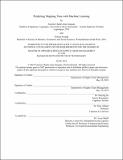Predicting Shipping Time with Machine Learning
Author(s)
Jonquais, Antoine; Krempl, Florian
DownloadJonquais_Krempl_2019.pdf (1.256Mb)
Metadata
Show full item recordAbstract
With the globalization of trade, transit time reliability has become a critical point in the shipping industry
as irregularities will lead to more delays further down the supply chain. Our sponsoring company, A.P.
Møller – Mærsk A/S (Maersk) provides freight forwarding services to its clients, offering them a complete
set of supply chain solutions for shipping their goods across the world. Currently Maersk uses an in-house
tool, Harmony, which provides descriptive analytics for shipment times and their variations based on
historical distributions. However, Maersk is facing commercial pressure from its customers for a better
estimation of its shipment transit time reliability, which has become a key measurement of its operational
performance. The goal of our project was to determine whether Machine Learning and predictive analytics
can improve the estimated time of arrival for a shipment. Using Machine Learning computing, we
developed a model capable of predicting shipping times by training the algorithms on historical shipment
data, and incorporating external sources of data related to the most impactful factors regarding schedule
reliability (e.g. holiday seasons and port congestion levels). We found that Machine Learning in this
instance might be a partial answer to this problem, as it performs better on long lead time than on short lead
time when comparing to more classical approaches. Our model has a mean absolute error (MAE) of 3.74
days when making a prediction at the time of booking transportation whereas our baseline model (which
only considers historical average transit times on a shipping lane) predicts with a 4.3 days MAE at the same
time. When making a prediction at the time the vessel leaves the port of origin, the two models actually
perform similarly, with a MAE of 2.1 days for both.
Date issued
2019Keywords
Risk Management, Transportation, Forecasting, Machine Learning